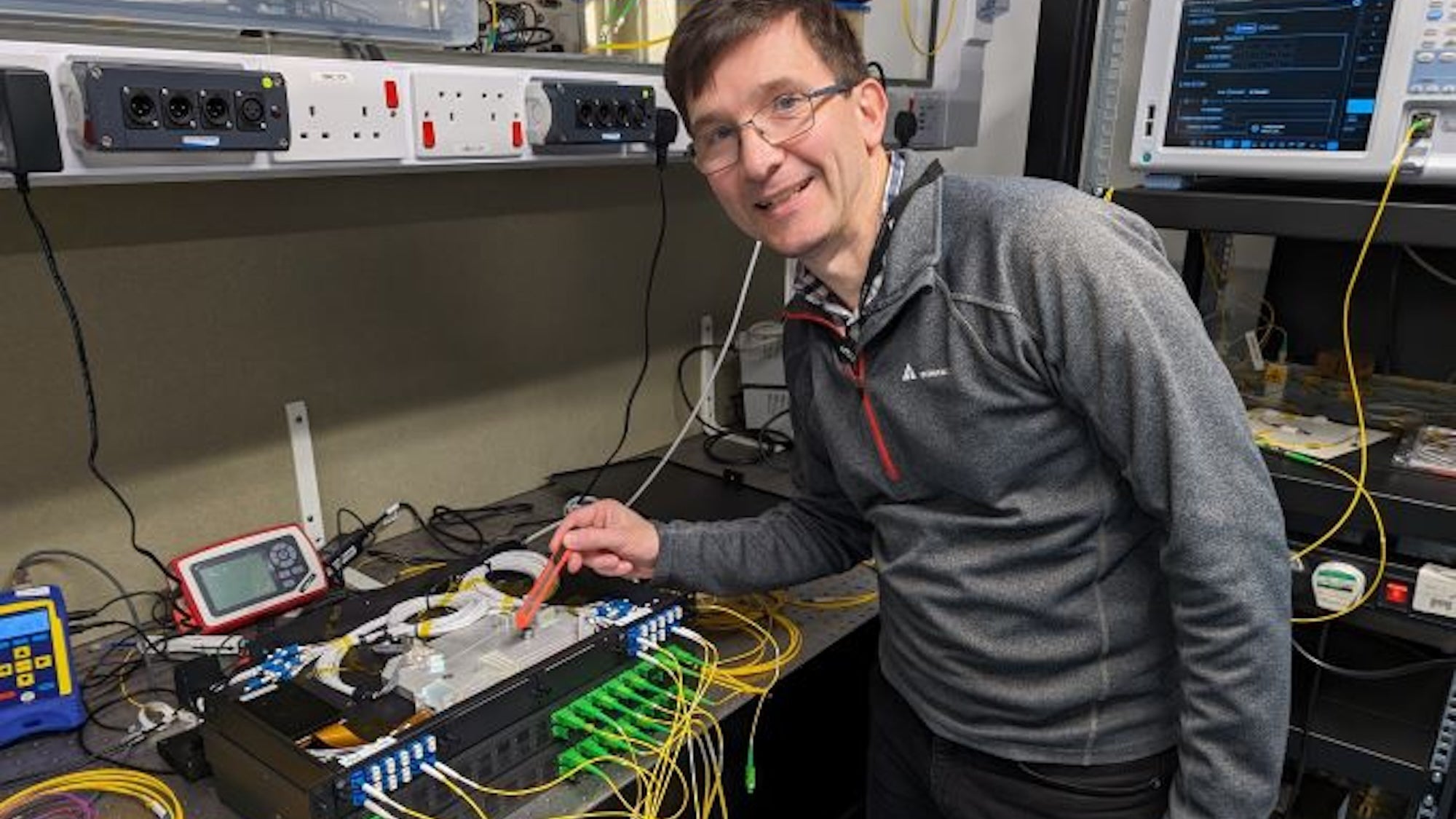Wow! That site sucks on mobile.
They want you to try the updated fiber optic connection
Works fine on mine
PopSci in general has seen better days. I tried subscribing again to their physical magazines and it’s just a mess… There were more full page cigarette ads than interesting articles.
With further refinement and scaling, internet providers could ramp up standard speeds without overhauling current fiber optic infrastructures.
Don’t worry. They’ll find some way to use this to justify massive rate increases.
We must make ISPs a public service owned by the people. Who can argue that internet isn’t essential to being a regular member of society? These companies rob us and use their monopolies to manipulate us.
It’s compared to the average broaband speed in the UK, so it’s not quite as exciting as it might sound …
So it’s barely faster than my phones internet when I’m traveling through nature.
Broadband is not a speed.
Do you know how fast you were going?
Faster than broadband…
Faster than “[…] the bandwidth of a station wagon full of tapes hurtling down the highway”?
(Quoted: Tanenbaum, 1981)
There are limitations to the technology, similar to saying 3 times faster than sound.
Also broadband as a regulated term would have speeds tied to that definition.
according to the FTC or FCC whichever one it was recently raised the defined speed of a broadband connection.
It’s not symmetrical yet though. Which is weird.
It’s not symmetrical yet though. Which is weird.
Eh, I would say it’s to be expected. A lot of infrastructure still relies on coax/DOCSIS which has its limitations in comparison to an all-fiber backbone. (This post has some good explanations.) However it wouldn’t surprise me if some ISPs argue that “nobody needs that much uplink” and “it helps restrict piracy” when really it’s just them holding out against performing upgrades.
it really shouldnt be though, this is going to be in effect for like, the next decade or two. FTTH is literally fresh off the presses for most suburbanites, and city dwellers, i see no reason that this standard should be so antiquated anymore.
Literally only incentivizes ISPs to keep rolling out shitty infra that’s slow as balls everywhere that isn’t suburbia.
With data caps, you can now go over your limit 1.2 billion times faster!
Cool I’ll be able to download CoD in just a few hours.
I’m highly suspicious about group dispersion over long distances. Today’s infrastructure was developed for a certain range of frequencies. Broading it right away wouldn’t be applicable that easy - we would need to introduce error correction which compromises the speed multiplier.
Too lazy to get the original paper though
The zero dispersion wavelength of G.652.D fiber is between 1302 nm and 1322 nm, in the O-band.
Dispersion pretty much linearly increases as you move away from its zero dispersion wavelength.
Typical current DWDM systems operate in the range of 1528.38 nm to 1563.86 nm, in the C-band.
Group dispersion in the E-band and S-band is lower than at current DWDM wavelengths, because these bands sit between the O-band and the C-band.
We already have transceivers that perform forward error correction. That technology is a decade+ old.
It is, but it compromises the speed exponentially with length/broadening
Dispersion compensation and FEC are separate layers of the cake, and work hand in hand.
I don’t understand why, tho I do not have any kind of expertise here.
I suggest (Haven’t read it), this paper proposes to send much denser and broadened signals around one carrier frequency (they use single mode). Due to dispersion they
-
Start to overlap with one each other. If you put more frequencies, you would have more overlaps and I fail to see how it won’t lead to errors.
-
They all arrive at the broader time window, which again could be mitigated either by error correction, or by extending the time window.
“I haven’t read it, but I assume these are things they didn’t take into account.”
Okay then.
Okay, let’s read and find out whether we can find something that we don’t know.
-
There’s no paper, there is no letter, it’s a simple statement at the institute page. The way science is being communicated nowadays is frustrating.
-
From the statement
However, alongside the commercially available C and L-bands, we used two additional spectral bands called E-band and S-band. Such bands traditionally haven’t been required because the C- and L-bands could deliver the required capacity to meet consumer needs.
So they indeed broadened the frequency range.
- They also did not say anything about limitations. They just pushed this bizarre number everywhere 🤷🏼♂️
if there is a paper you probably can’t read it because it’s published behind a pay wall, because fuck normies i guess.
-
-
Distances though? I’ve seen similar breakthroughs in the past but it was only good for networking within the same room.
It’s optical fiber so it’s good for miles. Unlikely to be at home for decades but telcos will use it for connecting networks.
Optical fiber is already 100 gigabit so the article comparing it to your home connection is stupid.
So the scientist improved current fiber speed by 10x, not 1.2 million X.
Its not stupid at all. “Broadband” speed is a term that laypeople across the country can at least conceptualize. Articles like this aren’t necessarily written exclusively for industry folks. If the population can’t relate to the information well, how can they hope to pressure telcos for better services?
So it’s fine if an article says Space X develops a new rocket that travels 100x faster than a car?
Because that implies a breakthrough when it’s actually not significantly faster than other rockets: it’s the speed needed to reach the ISS.
10X faster than existing fiber would be accurate reporting. Especially given that there are labs that have transmitted at peta bit speeds over optical already. So terabit isn’t significant, only his method.
Those are two completely unrelated things.
Then give me a related analogy you would accept and I’ll easily twist it into a misleading comparison exactly the article did.
How about this, “British Telecom develops high speed internet 1700x faster than previous Internet service technology. Availability is today!”
The above statement is completely true.
Comparing to home Internet when it isn’t home Internet technology is misleading. Ignoring that there are already faster optical Internet speeds in other labs around the world is misleading.
“A bus on average can hold ten times as many passengers as private vehicles.”
Except that isn’t the case here. It’s completely different technology that transfers the data. So it’s comparing a train to a car.
It’s much more than just 100Gb/s.
A single fiber can carry over 90 channels of 400G each. The public is mislead by articles like this. It’s like saying that scientists have figured out how to deliver the power of the sun, but that technology would be reserved for the power company’s generation facilities, not your house.
over 90 channels of 400G each
You mean with 50 GHz channels in the C-band? That would put you at something like 42 Gbaud/s with DP-QAM64 modulation, it probably works but your reach is going to be pretty shitty because your OSNR requirements will be high, so you can’t amplify often. I would think that 58 channels at 75 GHz or even 44 channels at 100 GHz are the more likely deployment scenarios.
On the other hand we aren’t struggling for spectrum yet, so I haven’t really had to make that call yet.
It’s optical fiber so it’s good for miles.
OM1 through OM4 have full rate distances of less than 800 meters.
Yes there is faster stuff that goes for literal miles but saying that optical fiber can always go miles is incorrect.
To be fair it’s obviously meant that they’re talking about singlemode and not multimode.
No one said “always”; original comment is correct that fiber can literally go miles
Note they did not say 1.2 million times faster than fiber. Instead they compared it to the broadband definition; an obvious choice of clickbait terminology.
I wonder what non-telco applications will use this
I wonder if something like a sport stadium has video requirements that would get close with HFR 8K video?
Disaggregated compute might be able to leverage this in the data center. I could use this to get my server, gaming PC and home theater to share memory bandwidth on top of storage, heck maybe some direct memory access between distributed accelerators.
Gotta eat those PCI lanes somehow
Disaggregated compute might be able to leverage this in the data center.
I don’t think people would fuck with amplifiers in a DC environment. Just using more fiber would be so much cheaper and easier to maintain. At least I haven’t heard of any current Datacenters even using conventional DWDM in the C-band.
At best Google was using Bidir Optics, which I suppose is a minimal form of wavelength division multiplexing.
To be fair, it all trickles down to home users eventually. We’re starting to see 10+gbps fiber in enthusiast home networks and internet connections. Small offices are widely adopting 100gbps fiber. It wasn’t that long ago that we were adopting 1 gigabit ethernet in home networks, and it won’t be long before we see widespread 800+ gigabit fiber.
Streaming video is definitely a big application where more bandwidth will come in handy, I think also transferring large AI models in the 100s of gigabytes may also become a large amount of traffic in the near future.
Man. The tech is so pricey though. 10g switch’s are scary lol
Yeah. I honestly think 10GbaseT was a mistake, since it fragmented 10gbit and made it so expensive.
The sfp+ switches aren’t too bad, here’s an 8 port unmanaged for $150: https://www.amazon.com/MokerLink-Support-Bandwidth-Unmanaged-Ethernet/dp/B09W24RZDC/
SFP+ still pretty much requires pcie cards or home-server style hardware to use, but it’s pretty accessible. And you can buy 10GbaseT adapters for backwards compatibility for $40.
Some wifi routers are even starting to adopt SFP+, even if it’s ungodly expensive. https://www.amazon.se/TP-Link-Deco-BE85-2-pack-Tri-Band-router/dp/B0C5Y46J1W/
Yup, my city has historically had mediocre Internet, and now they’re rolling out fiber and advertising 10g/s at a relatively reasonable $200/month.
I’m probably not getting it anytime soon (I’m happy with my 50/20 service), but I know a few enthusiasts who will. I’ll see what the final pricing looks like and decide if it’s worth upgrading my infrastructure (only have wireless AC, so no point in going above 300mbps or so).
Source article is here https://www.aston.ac.uk/latest-news/aston-university-researchers-send-data-45-million-times-faster-average-broadband
One originally linked is re-post of re-post.
I remember the early 90’s when fiber connection was being developed in research centers.
Researchers had found a way to transmit all of a country’s phone calls’ bandwidth through a simple fiber cable. Then, they wondered: what could we use this for?
This was a few years before the explosion of the internet…
1988 TAT-8 already went into productive use as the first transatlantic fiber optic connection. So the lab work must have happened in the 80’s already.
Its a shame i dont have an ethernet cable that fast or a motherboard with a network interface capable of that speed.
Great if i can get faster fibre into my home but my internal infrastructure is not up to the task. This wont be in the home until we can use fibre cables like we currently use ethernet cables.
Or is there some other tech that would replace ethernet that would handle those speeds. Also whats my wrote speed on my ssd?
Yeah i dont know if thisnis a tech thats meant for home, more likely large businesses with lots of devices all fighting for bandwidth.
It will only be used for corporations, but at some point we will also get it for our homes, but not yet. Also Theres still a lot of research to do before this will be used anywhere.
The closest that comes to mind are QSFP cables.
xfinity will advertise 100 Tbps lines with the abysmal 1.5 TB/mo data cap anyway
“you can drive this super sport car for $ per month - but only for 10 miles”
Don’t be silly son, the free market will signal there is opportunity and prices will drop and quality will go up.
🤪
All fed to you on the not updated data line that caps at 800 MBps
I hate Comcast as much as the next guy but I feel like 1.5TB a month would be reasonable. Even at those speeds you probably wouldn’t be downloading more, just downloading whatever you do now but faster.
E: I was gonna ask why this was so controversial but I just checked my routers stats and, oh yeah I’ve only downloaded around half a terabyte over 3 segregated VLANs in the past 2 months. I’ve uploaded almost double that which is baffling to me though. Even still I don’t see why anyone would be downloading anything more that a terabyte in a month unless your one of those data hoarders, which fair but… I’ll stop my rambling.
I’m on pace for 0.60 TB this month and I’m no heavy user. I only have 1 4k TV and a laptop for work that I use all day. My wife is mostly on her phone but is a heavy TV user in the evening. I can imagine people who download and/or torrent most of the content they consume can easily hit 1.5TB
There shouldn’t be any data caps on wired connections, especially fiber.
The only thing data caps should affect is if there’s abnormal congestion.
There should be, that’s just how fiber works. If they lay a 10 Gb line in the street, they’ll probably sell a 1 Gb connection to a 100 households. (Margins depend per provider and location)
If they give you an uncapped connection to the entire wire, you’ll DoS the rest of the neighborhood
That’s why people are complaining “I bought 1Gb internet, but I’m only getting 100Mb!” - They oversold bandwidth in a busy area. 1Gb would probably be the max speed if everyone else was idle. If they gave everyone uncapped connections the problem would get even worse
you’re talking about a bandwidth cap, not a data cap. data caps are when you get throttled after downloading a certain amount of data or get charged extra. think phone data plans where you have 10 or 20gb or whatever per month
Maybe, just maybe… Don’t oversell your capacity.
You’re taking about data rates here, measured in bits per second.
Data caps have to do with the total amount of data you are allocated over a longer period of time. Usually per month. In the case of Comcast, it’s 1.5 TB/month.
If the customer exceeds that allotment during the month, they will be charged an additional “overage fee” per arbitrary unit, usually by the gigabyte.
It has nothing to do with the speed they advertise on a line, but rather a way to charge “heavy users” more.
Why the fuck would I want that speed if I can only fully use it for less than a second before hitting the data cap? I’d rather have 100 times less speed with 100 times more cap, so I can actually fully use it however I want.
Also it’s just ridiculous anyway because I don’t even think hard drive write speeds are that fast.
I think you meant no data cap.
Data caps are simply false advertising - if your infrastructure can only handle X Tb/s then sell lower client speeds or implement some clever QoS.
There are plenty of users for whom 1.5TB is quite or very restrictive - multi member households, video/photo editors working with raw data, scientists working with raw data, flatpak users with Nvidia GPU or people that selfhost their data or do frequent backups etc.
With the popularity of WFH and our dependence on online services the internet is virtually as vital as water or electricity, and you wouldn’t want to be restricted to having no electricity until the end of the month just because you used the angle grinder for a few afternoons.
Florida man fails math, yet again
I’m not even from Florida 😭😭 Planning on a namechange for my Internet personality soon though
Tell that to my (nonexistent) off-site backup.
100Tbps downloads speeds (5Mbps upload)
Speeds not guaranteed…
Isn’t the phrase they use “up to” the promised speed? So if it is 300bps, that is not above 5Mbps, so they technically met their promise.
Aren’t fiber lines typically symmetrical? At least that’s how I’ve usually seen them advertised.
You underestimate the fuckery that ISPs will go through to offer the least amount of services for the most possible money.
Mine at least lets me adjust the upload and download ratio for my plan. I’m currently on 50/20, but I could upgrade my plan and get 100/20, 70/50, or whatever I want. But 50/20 has been plenty for me, and we’re getting municipal fiber soon so I’ll have more options as well.
AFAIK, cable doesn’t offer that, you get 5mbps on pretty much every plan, or you upgrade to some ridiculous tier to get faster upload.
5Mbps is absolutely bonkers. I had 30/5 back in like 2006. And TCP has an overhead of about 5%, some protocols ever more.
I lost my symmetric gigabit fiber recently after moving and I miss it dearly. Might have upgraded to 3Gbps by now 😭
I had gigabit a long time ago, and while it was nice, I’m unwilling to pay for it. 50/25 is good enough for me, and it costs less than half what gigabit would cost ($55/month vs $125/month). I just checked, and apparently all plans have half the upload vs download, so that’s nice.
Our new service promises to be $60-70 for 250 symmetric, and that would only get me 100/50 at my current ISP, so I’ll probably be getting that upgrade when it’s available.
My docter said i needed more fiber.
And 1.2 million times less likely to be available to the public
No normal consumer user would have any reasonable use case for this kind of bandwidth.
This is data center and backbone network stuff.
ultimately the end consumer is going to run their connection through it SOMEWHERE, or something very similar more than likely.
It’s not going to be FTTH levels of connectivity, but interconnect to ISP it very well could be.
Maybe so. Would sure be nice to have that kind of breathing room though
Also 1.2 million times less likely to leave the research stadium because even if this is true (very big if already) it’s still “new and exciting and revolutionary improvement #3626462” this week alone. Revolutionary new battery tech comes out twice a week if you believe the pop sci tech sites, it’s 99.9% crap
Stuff like this is a bit more believable. Still will be more than a decade before we will see any benefit. First all of the sea cables would get the upgrade, then private companies (banks mainly), then governments (military and such), ISPs will prolly not touch it for as long as possible till governments force em.
Battery advancements aren’t crap. We’ve gotten 5-8% improvement in capacity per year, which compounds to a doubling every 10 to 15 years. Every advancement covered by over sensationalized pop sci articles you’ve ever heard has contributed to that. It’s important not to let sensationalism make you jaded to actual advancements.
Now, as for broadband, we haven’t pushed out the technologies to the last mile that we already have. However, this sort of thing is useful for the backbone and universities. Universities sometimes have to transfer massive amounts of data, and some of the most efficient ways to do that are a van full of hard drives.
That’s not what I said though, I meant that 99.9% of the “revolutionary new battery technology” articles on blogs, magazines and what not are clickbait crap. I’ve seen these articles for at least the last 25 years and hlbeyond lit-ion batteries, not much revolutionary has happened on the battery front. My point was more against the clickbait science and tech news that regurgitates the same dumb crap all the time
remember kids, commit arson against your local ISP, and you will only be arrested for probably 20 years.



















